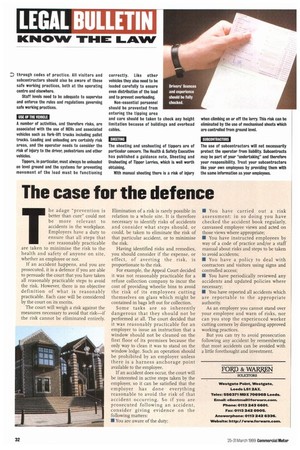The case for the defence
Page 34

If you've noticed an error in this article please click here to report it so we can fix it.
The adage "prevention is better than cure" could not be more relevant to accidents in the workplace. Employers have a duty to ensure that all steps that are reasonably practicable are taken to minimise the risk to the health and safety of anyone on site, whether an employee or not.
If an accident happens, and you are prosecuted, it is a defence if you are able to persuade the court that you have taken all reasonably practicable steps to avoid the risk. However, there is no objective definition of what is reasonably practicable. Each case will be considered by the court on its merits.
The court will weigh a risk against the measures necessary to avoid that risk—if the risk cannot be eliminated entirely.
Elimination of a risk is rarely possible in relation to a whole site. It is therefore necessary to identify risks of accidents and consider what steps should, or could, be taken to eliminate the risk of that particular accident, or to minimise the risk.
Having identified risks and remedies, you should consider if the expense, or effect, of averting the risk, is proportionate to the risk.
For example, the Appeal Court decided it was not reasonably practicable for a refuse collection company to incur the cost of providing wheelie bins to avoid the risk of its employees cutting themselves on glass which might be contained in bags left out for collection.
Some tasks are so inherently dangerous that they should not be performed at all, The court decided that it was reasonably practicable for an employer to issue an instruction that a window should not be cleaned on the first floor of its premises because the only way to clean it was to stand on the window ledge. Such an operation should be prohibited by an employer unless there is a harness anchorage point available to the employee.
If an accident does occur, the court will be interested in active steps taken by the employer, so it can be satisfied that the employer has done everything reasonable to avoid the risk of that accident occurring. So if you are prosecuted following an accident, consider giving evidence on the following matters: • You are aware of the duty; • You have carried out a risk assessment: in so doing you have checked the accident book regularly, canvassed employee views and acted on those views where appropriate; • You have instructed employees by way of a code of practice and/or a staff manual about risks and steps to be taken to avoid accidents; • You have a policy to deal with contractors and visitors using signs and controlled access; • You have periodically reviewed any accidents and updated policies where necessary;
II You have reported all accidents which are reportable to the appropriate authority.
As an employer you cannot stand over your employee and warn of risks, nor can you stop the experienced worker cutting corners by disregarding approved working practices.
But you can try to avoid prosecution following any accident by remembering that most accidents can be avoided with a little forethought and investment.
















































































































